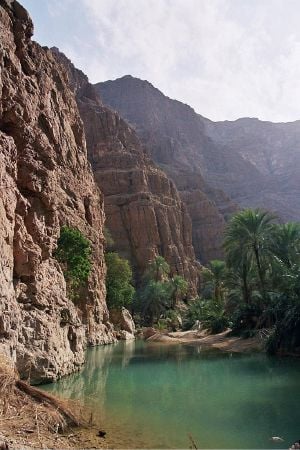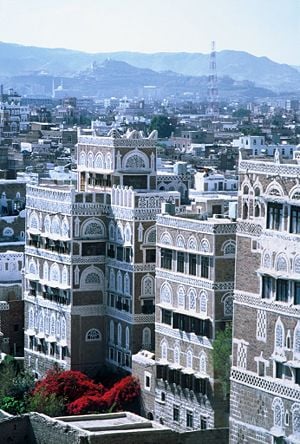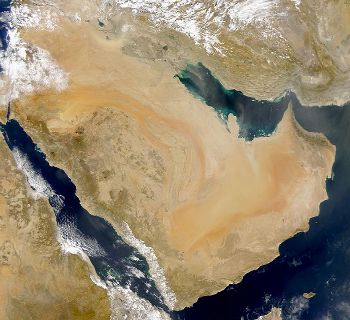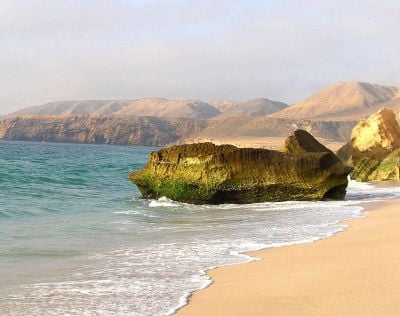Difference between revisions of "Arabian Peninsula" - New World Encyclopedia
m (Robot: Changing Category:Geography and demographics) |
|||
| (30 intermediate revisions by 7 users not shown) | |||
| Line 1: | Line 1: | ||
| − | {{ | + | {{Copyedited}}{{Approved}}{{Submitted}}{{Images OK}}{{Paid}} |
| − | [[ | + | [[File:Arabian Peninsula dust SeaWiFS.jpg|thumb|350px|Satellite image of the Arabian Peninsula]] |
| − | |||
| − | The | + | The '''Arabian Peninsula''' ([[Arabic language|Arabic]]: شبه الجزيرة العربية ''šabah al-jazīra al-{{Unicode|ʻ}}arabīyya'' or جزيرة العرب ''jazīrat al-{{Unicode|ʻ}}arb'') is a [[peninsula]] in [[Southwest Asia]] at the junction of [[Africa]] and [[Asia]] consisting mainly of [[desert]]. The area is an important part of the [[Middle East]] and plays a critically important [[geopolitics|geopolitical]] role because of its vast reserves of [[petroleum|oil]] and [[natural gas]]. |
| − | + | The coasts of the peninsula are, on the west the [[Red Sea]] and the [[Gulf of Aqaba]], on the southeast the [[Arabian Sea]] (part of the [[Indian Ocean]]), and on the northeast, the [[Gulf of Oman]], the [[Strait of Hormuz]], and the [[Persian Gulf]]. | |
| − | Politically, the | + | Its northern limit is defined by the [[Zagros]] collision zone, a mountainous uplift where a continental collision between the Arabian Plate and Asia is occurring. It merges with the [[Syrian Desert]] with no clear line of demarcation. |
| − | *[[Kuwait]] | + | {{toc}} |
| − | *[[Oman]] | + | Geographically, the Arabian Peninsula includes parts of [[Iraq]] and [[Jordan]]. [[political geography|Politically]], however, the peninsula is separated from the rest of Asia by the northern borders of Kuwait and Saudi Arabia. |
| − | *[[Qatar]] | + | |
| − | *[[Saudi Arabia]] | + | These countries (called the [[Arab states of the Persian Gulf|Arab Gulf states]]) are among the wealthiest in the world (with the exception of [[Yemen]]). |
| − | *[[United Arab Emirates]] | + | |
| + | ==Geography== | ||
| + | The following countries are politically considered part of the peninsula: | ||
| + | |||
| + | *[[Bahrain]], an [[island]] nation off the east coast of the peninsula. | ||
| + | *[[Kuwait]] | ||
| + | *[[Oman]] | ||
| + | *[[Qatar]] | ||
| + | *[[Saudi Arabia]] | ||
| + | *[[United Arab Emirates]] | ||
*[[Yemen]] | *[[Yemen]] | ||
| + | The [[climate]] of the Arabian Peninsula is extremely dry and arid. As is common in the neighboring area, the Arabian Peninsula receives very little annual [[rain]]fall. Compounding the lack of [[precipitation]], the Arabian Peninsula also has few [[lake]]s or permanent [[river]]s, two facts which combine to produce an extremely dry landscape that is not conducive to settled [[civilization]]s. The few rivers that do exist in the region, referred to as wadis, are only full during the wet seasons. During any other period of time the wadis are dry. The dry climate, combined with lack of available water, does not permit large scale agricultural development. The only place where cultivation can occur is near the oases, but these are very few locations within a desert so large. | ||
| + | [[Image:Ras al jinz flickr01.jpg|thumb|400px|Ras Aljinz, southeastern Arabia (Oman) also known as the 'Turtle Beach'.]] | ||
| − | The | + | Geographically, the terrain of the Arabian Peninsula consists of a large central plateau, a variety of deserts, marshy coast lands, and stretches of mountains. The main feature of the peninsula is the central plateau, which reaches a breathtaking height of 2,500 feet. Unlike many plateaus, the central plateau of the Arabian Peninsula is not flat; it slowly slopes towards the Gulf. The region as a whole is distinguished by a large variety of geographic variance, ranging from the central plateau to the stony deserts in the north, and the coast lands that are resplendent with coral reefs in the [[Red Sea]]. The Arabian Peninsula also boasts the largest uninterrupted sand dune in the world, called the Empty Quarter. The Empty Quarter runs for 40 kilometers and features linear sand dunes. |
| + | [[Image:Oman-Wadi-Shab-26.jpg|thumb|300px|Wadi Shab, [[Oman]]]] | ||
| + | Some geologists claim that the Arabian Peninsula should be more accurately classified as a subcontinent, due to the fact that it is placed on a tectonic plate that is completely separate from any neighboring continents. To support this theory, the geologists claim that the tectonic plate the Arabian Peninsula is on is slowly moving away from the plate under northeast [[Africa]]. | ||
| − | + | ==Economy== | |
| + | The primary exports of the Arabian Peninsula are [[oil]] and [[natural gas]], both of which are found abundantly in the region. Because these commodities are desired by industrialized nations around the world, the Arabian Peninsula can use its [[natural resource]]s as a means to direct [[Politics|political]] action. The ability to use oil as a political force is most apparent in the [[Organization of Petroleum Exporting Countries]] (OPEC) that unites all of the oil exporting countries in the region as a political unit. By consolidating the political power of all the oil exporting countries, OPEC is able to guide political action in the world through the threat of withholding oil resources. The influx of wealth from the oil industry also provides many of the necessary services for governments in the region, such as the funds for construction projects or the financial service sector. | ||
| − | + | ==History== | |
| + | [[Image:Sanaa.JPG|thumb|300px|The old part of [[Sanaa]], [[Yemen]]]] | ||
| + | The earliest inhabitants of the Arabian Peninsula were [[nomad]]ic herdsmen, who passed through the area seeking fresh pastures for their livestock. It is through the movements of the earliest nomadic people in the Arabian Peninsula that it is possible to reconstruct an image of the historic desert area, most particularly through the accounts of Semitic speaking people of Akkadian that passed through the Arabian Peninsula when seeking the Tigris and [[Euphrates River]] Valley. | ||
| − | + | The earliest [[civilization]]s in the Arabian Peninsula were formed in the wetter portions of the peninsula, lying in the extreme southwest corner. These early civilizations, the [[Minaean]], the [[Sabaean]], and the [[Himyarites]], capitalized on the Arabian Peninsula's unique geographic position to become major players in international commerce. It is thought by some historians that the [[Queen of Sheba]], mentioned in the [[Bible]], was actually the ruler of the Sabeans during the height of their power. The rise of these kingdoms was facilitated by the abundance of [[frankincense]] and [[myrrh]] in the area, which fetched a high price on the market. Control of these, and other, [[spice]]s quickly became a point of contention in the ancient world, leading the prefect of [[Egypt]] to launch a military attack to gain control of the trade. The attack failed, and the Himyarites continued to dominate trade in the area until the [[Ancient Rome|Romans]] created trade routes towards the Red Sea. The [[Persian Gulf]] was also a vitally important water route to ancient world trade, as sailors could travel along the gulf without ever losing sight of land. | |
| − | + | The power of the Himyarites began to falter in the early third century, when rival economic power Aksum attempted to assert political control over the fledging Arabian Peninsula empires. The [[East Africa]]n [[Kingdom of Aksum]] was particularly interested in territorial expansion, and in their attempt to expand, their desires overlapped with the territory of the Himyarites. At its strongest, the kingdom of Aksum extended into [[Yemen]] and western [[Saudi Arabia]], both countries which are commonly included in the definition of the Arabian Peninsula. | |
| − | |||
| − | |||
| − | |||
| − | + | The early history of trade in the Arabian Peninsula set the stage for modern times, when the area is still noted for its high level of [[natural resource]] exportation. One thing that has changed, however, is the main export of the region, which has switched from [[spice]]s to [[petroleum]] products. In the modern world, most industrialized nations require a steady supply of oil to continue production, a fact that launched the Arabian Peninsula into the center of the economic scene. Oil is a particularly strong export of the region, with the Arabian Peninsula boasting the world's largest reserve of petroleum. Most of the oil lies within the political borders of the [[Kingdom of Saudi Arabia]], which extends over the majority of the Arabian Peninsula. | |
| + | Culturally, the Arabian Peninsula is considered to be the homeland of the Proto-Semitic language family. This [[language]] family is thought by many linguists to be the original language of the majority of people in the region including: [[Akkadia]]ns, [[Arab]]s, [[Assyria]]ns, and [[Hebrew]]s. According to this theory, the Arabian Peninsula was the birth place of most Middle Eastern languages. It is also in this region that a few speakers of rare Southern East Semitic languages can be found, and not anywhere else in the world. Most of the population adheres to the tenets of [[Islam]], and are guided by religious law in their everyday lives. This fact is particularly notable in Saudi Arabia and Yemen, which boast higher population levels that other countries in the region. The religious life of the Arabian Peninsula is concentrated in [[Mecca]] and [[Medina]], both vitally important cities to the followers of Islam. | ||
| − | + | ==References== | |
| + | * Clark, Arthur P., Muhammad A. Tahlawi, William Facey, and Thomas A. Pledge. 2006. ''A Land Transformed: The Arabian Peninsula, Saudi Arabia, and Saudi Aramco''. Dhahran, Saudi Arabia: The Saudi Arabian Oil Company (Saudi Aramco), 2007. ISBN 0960116400 | ||
| + | * Costantino, Maria. ''The Illustrated Flag Handbook''. New York: Gramercy Books, 2001. ISBN 0517218100 | ||
| + | * Edgell, H. Stewart. ''Arabian deserts nature, origin and evolution''. Dordrecht: Springer, 2006. ISBN 9781402039690 | ||
| + | * Lewis, Brenda Ralph. ''Great Civilizations''. Bath: Paragon Publishing, 2002. ISBN 0752561413 | ||
| + | * Linzee Gordon, Frances. ''Arabian Peninsula''. Lonely Planet, 2004. ISBN 9781741042948 | ||
| + | ==External links== | ||
| + | All links retrieved December 29, 2023. | ||
| + | * [https://www.nationsonline.org/oneworld/map/Arabia-Map.htm Map of the Arabian Peninsula, Middle East] ''One World - Nations Online'' | ||
| + | * [https://www.loc.gov/resource/gdcwdl.wdl_18813/ Map of the Arabian Peninsula.] ''Library of Congress'' | ||
| + | |||
| + | ---- | ||
| + | |||
| + | {{Regions of the world}} | ||
| + | |||
| + | [[Category:Geography]] | ||
[[Category:Peninsulas]] | [[Category:Peninsulas]] | ||
| − | + | ||
| + | {{credit|168129572}} | ||
Latest revision as of 21:35, 29 December 2023
The Arabian Peninsula (Arabic: شبه الجزيرة العربية šabah al-jazīra al-ʻarabīyya or جزيرة العرب jazīrat al-ʻarb) is a peninsula in Southwest Asia at the junction of Africa and Asia consisting mainly of desert. The area is an important part of the Middle East and plays a critically important geopolitical role because of its vast reserves of oil and natural gas.
The coasts of the peninsula are, on the west the Red Sea and the Gulf of Aqaba, on the southeast the Arabian Sea (part of the Indian Ocean), and on the northeast, the Gulf of Oman, the Strait of Hormuz, and the Persian Gulf.
Its northern limit is defined by the Zagros collision zone, a mountainous uplift where a continental collision between the Arabian Plate and Asia is occurring. It merges with the Syrian Desert with no clear line of demarcation.
Geographically, the Arabian Peninsula includes parts of Iraq and Jordan. Politically, however, the peninsula is separated from the rest of Asia by the northern borders of Kuwait and Saudi Arabia.
These countries (called the Arab Gulf states) are among the wealthiest in the world (with the exception of Yemen).
Geography
The following countries are politically considered part of the peninsula:
- Bahrain, an island nation off the east coast of the peninsula.
- Kuwait
- Oman
- Qatar
- Saudi Arabia
- United Arab Emirates
- Yemen
The climate of the Arabian Peninsula is extremely dry and arid. As is common in the neighboring area, the Arabian Peninsula receives very little annual rainfall. Compounding the lack of precipitation, the Arabian Peninsula also has few lakes or permanent rivers, two facts which combine to produce an extremely dry landscape that is not conducive to settled civilizations. The few rivers that do exist in the region, referred to as wadis, are only full during the wet seasons. During any other period of time the wadis are dry. The dry climate, combined with lack of available water, does not permit large scale agricultural development. The only place where cultivation can occur is near the oases, but these are very few locations within a desert so large.
Geographically, the terrain of the Arabian Peninsula consists of a large central plateau, a variety of deserts, marshy coast lands, and stretches of mountains. The main feature of the peninsula is the central plateau, which reaches a breathtaking height of 2,500 feet. Unlike many plateaus, the central plateau of the Arabian Peninsula is not flat; it slowly slopes towards the Gulf. The region as a whole is distinguished by a large variety of geographic variance, ranging from the central plateau to the stony deserts in the north, and the coast lands that are resplendent with coral reefs in the Red Sea. The Arabian Peninsula also boasts the largest uninterrupted sand dune in the world, called the Empty Quarter. The Empty Quarter runs for 40 kilometers and features linear sand dunes.

Some geologists claim that the Arabian Peninsula should be more accurately classified as a subcontinent, due to the fact that it is placed on a tectonic plate that is completely separate from any neighboring continents. To support this theory, the geologists claim that the tectonic plate the Arabian Peninsula is on is slowly moving away from the plate under northeast Africa.
Economy
The primary exports of the Arabian Peninsula are oil and natural gas, both of which are found abundantly in the region. Because these commodities are desired by industrialized nations around the world, the Arabian Peninsula can use its natural resources as a means to direct political action. The ability to use oil as a political force is most apparent in the Organization of Petroleum Exporting Countries (OPEC) that unites all of the oil exporting countries in the region as a political unit. By consolidating the political power of all the oil exporting countries, OPEC is able to guide political action in the world through the threat of withholding oil resources. The influx of wealth from the oil industry also provides many of the necessary services for governments in the region, such as the funds for construction projects or the financial service sector.
History

The earliest inhabitants of the Arabian Peninsula were nomadic herdsmen, who passed through the area seeking fresh pastures for their livestock. It is through the movements of the earliest nomadic people in the Arabian Peninsula that it is possible to reconstruct an image of the historic desert area, most particularly through the accounts of Semitic speaking people of Akkadian that passed through the Arabian Peninsula when seeking the Tigris and Euphrates River Valley.
The earliest civilizations in the Arabian Peninsula were formed in the wetter portions of the peninsula, lying in the extreme southwest corner. These early civilizations, the Minaean, the Sabaean, and the Himyarites, capitalized on the Arabian Peninsula's unique geographic position to become major players in international commerce. It is thought by some historians that the Queen of Sheba, mentioned in the Bible, was actually the ruler of the Sabeans during the height of their power. The rise of these kingdoms was facilitated by the abundance of frankincense and myrrh in the area, which fetched a high price on the market. Control of these, and other, spices quickly became a point of contention in the ancient world, leading the prefect of Egypt to launch a military attack to gain control of the trade. The attack failed, and the Himyarites continued to dominate trade in the area until the Romans created trade routes towards the Red Sea. The Persian Gulf was also a vitally important water route to ancient world trade, as sailors could travel along the gulf without ever losing sight of land.
The power of the Himyarites began to falter in the early third century, when rival economic power Aksum attempted to assert political control over the fledging Arabian Peninsula empires. The East African Kingdom of Aksum was particularly interested in territorial expansion, and in their attempt to expand, their desires overlapped with the territory of the Himyarites. At its strongest, the kingdom of Aksum extended into Yemen and western Saudi Arabia, both countries which are commonly included in the definition of the Arabian Peninsula.
The early history of trade in the Arabian Peninsula set the stage for modern times, when the area is still noted for its high level of natural resource exportation. One thing that has changed, however, is the main export of the region, which has switched from spices to petroleum products. In the modern world, most industrialized nations require a steady supply of oil to continue production, a fact that launched the Arabian Peninsula into the center of the economic scene. Oil is a particularly strong export of the region, with the Arabian Peninsula boasting the world's largest reserve of petroleum. Most of the oil lies within the political borders of the Kingdom of Saudi Arabia, which extends over the majority of the Arabian Peninsula.
Culturally, the Arabian Peninsula is considered to be the homeland of the Proto-Semitic language family. This language family is thought by many linguists to be the original language of the majority of people in the region including: Akkadians, Arabs, Assyrians, and Hebrews. According to this theory, the Arabian Peninsula was the birth place of most Middle Eastern languages. It is also in this region that a few speakers of rare Southern East Semitic languages can be found, and not anywhere else in the world. Most of the population adheres to the tenets of Islam, and are guided by religious law in their everyday lives. This fact is particularly notable in Saudi Arabia and Yemen, which boast higher population levels that other countries in the region. The religious life of the Arabian Peninsula is concentrated in Mecca and Medina, both vitally important cities to the followers of Islam.
ReferencesISBN links support NWE through referral fees
- Clark, Arthur P., Muhammad A. Tahlawi, William Facey, and Thomas A. Pledge. 2006. A Land Transformed: The Arabian Peninsula, Saudi Arabia, and Saudi Aramco. Dhahran, Saudi Arabia: The Saudi Arabian Oil Company (Saudi Aramco), 2007. ISBN 0960116400
- Costantino, Maria. The Illustrated Flag Handbook. New York: Gramercy Books, 2001. ISBN 0517218100
- Edgell, H. Stewart. Arabian deserts nature, origin and evolution. Dordrecht: Springer, 2006. ISBN 9781402039690
- Lewis, Brenda Ralph. Great Civilizations. Bath: Paragon Publishing, 2002. ISBN 0752561413
- Linzee Gordon, Frances. Arabian Peninsula. Lonely Planet, 2004. ISBN 9781741042948
External links
All links retrieved December 29, 2023.
- Map of the Arabian Peninsula, Middle East One World - Nations Online
- Map of the Arabian Peninsula. Library of Congress
| Regions of the world | |||||||||||||||||||||||||
|---|---|---|---|---|---|---|---|---|---|---|---|---|---|---|---|---|---|---|---|---|---|---|---|---|---|
|
| ||||||||||||||||||||||||
| See also Continents of the world | |||||||||||||||||||||||||
Credits
New World Encyclopedia writers and editors rewrote and completed the Wikipedia article in accordance with New World Encyclopedia standards. This article abides by terms of the Creative Commons CC-by-sa 3.0 License (CC-by-sa), which may be used and disseminated with proper attribution. Credit is due under the terms of this license that can reference both the New World Encyclopedia contributors and the selfless volunteer contributors of the Wikimedia Foundation. To cite this article click here for a list of acceptable citing formats.The history of earlier contributions by wikipedians is accessible to researchers here:
The history of this article since it was imported to New World Encyclopedia:
Note: Some restrictions may apply to use of individual images which are separately licensed.

